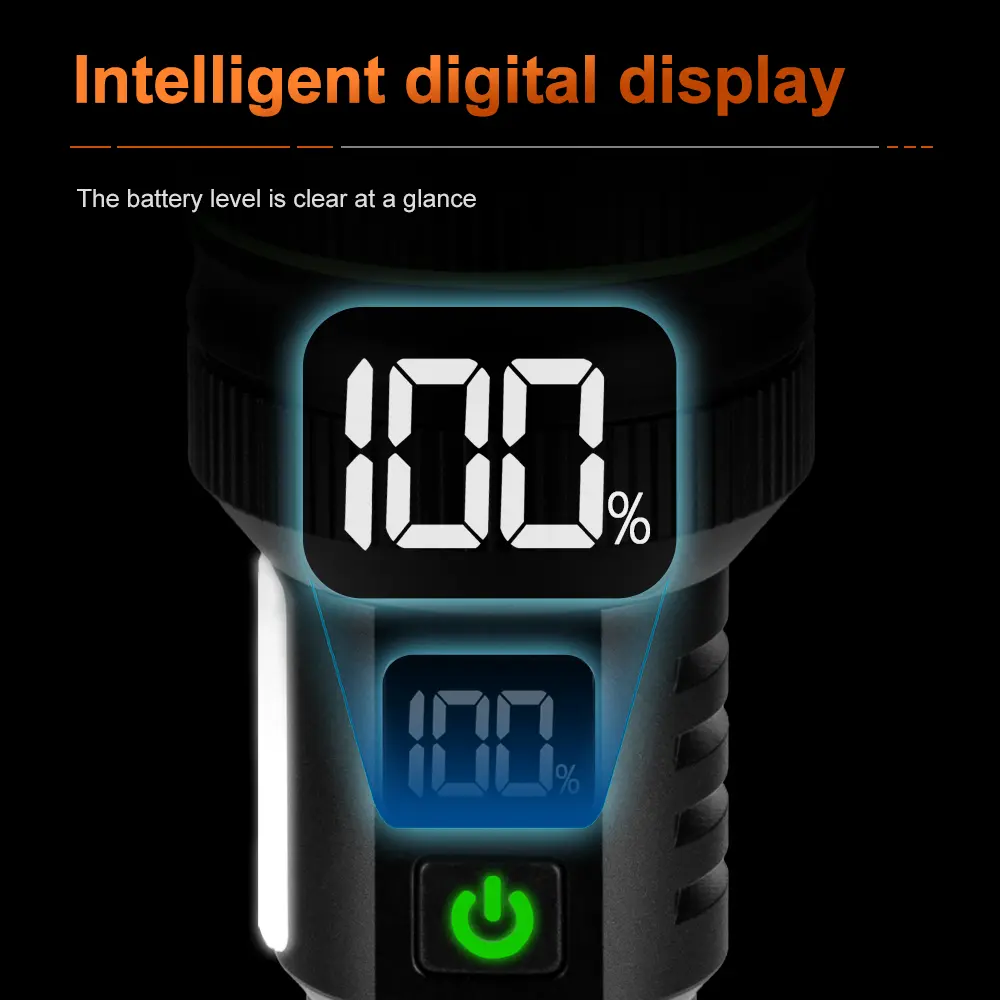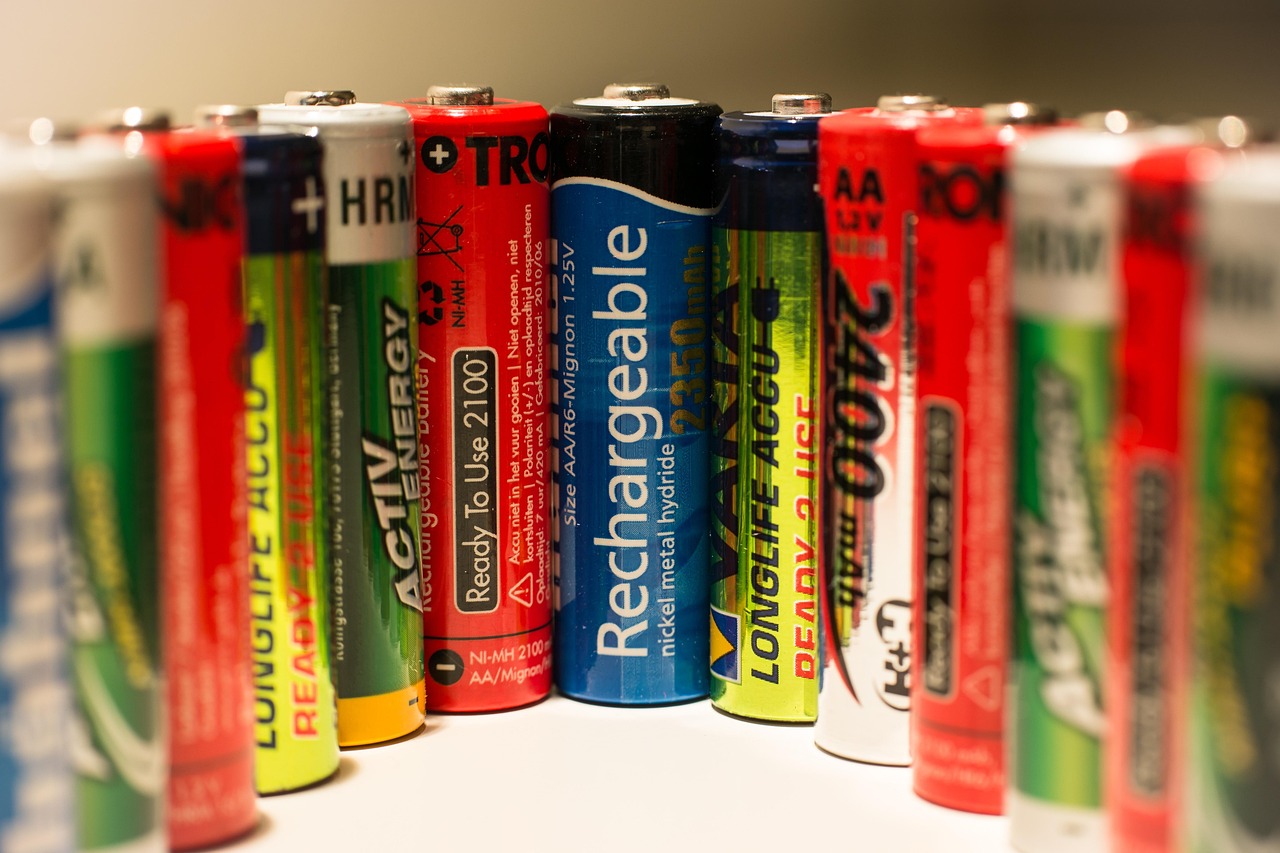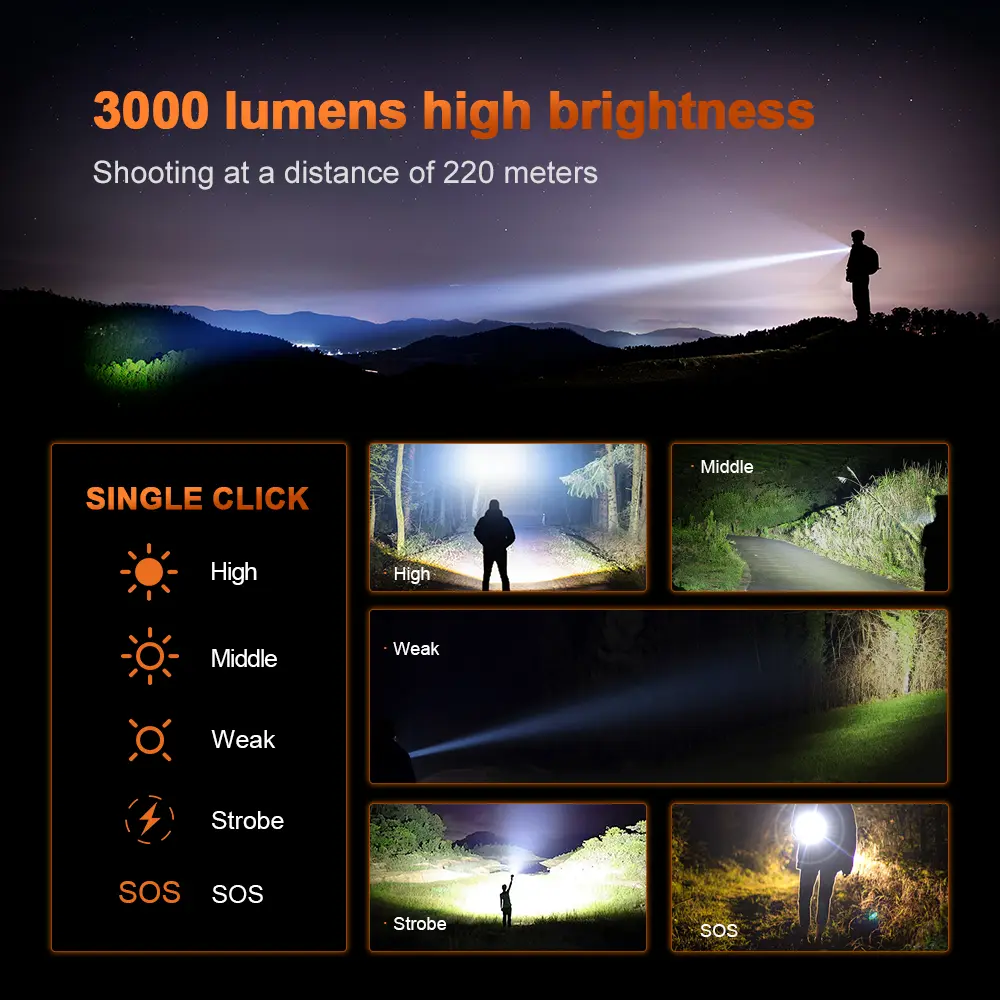How to Select a Flashlight with Long-Lasting Battery Life

Choosing a good flashlight with efficient battery consumption ensures reliability in emergencies and daily tasks. A flashlight using long-lasting batteries saves money and reduces waste. Rechargeable flashlights minimize hazardous waste and carbon emissions. LEDs consume less energy, enhancing battery efficiency. A good flashlight combines brightness, durability, and eco-friendly features for optimal performance.
Key Takeaways
Pick flashlights with LED bulbs for better battery life and brightness. LEDs can work for up to 100,000 hours, so they are dependable.
Use rechargeable batteries to save money and cut down on waste. They cost less over time and can be reused many times.
Check the flashlight's water resistance level. A higher level means it works well in wet weather, which is safer outdoors.
Understanding Flashlight Features
Light Output and Lumens
When choosing a flashlight, understanding light output is essential. Measured in lumens, light output determines how bright the flashlight will be. Flashlights designed for everyday use typically range between 100 and 400 lumens. For more demanding tasks, some models can reach up to 1000 lumens. A flashlight with adjustable brightness settings allows you to conserve battery life while tailoring the light output to your needs. Super bright flashlights are ideal for outdoor activities or emergencies, but they may drain the battery faster.
Beam Type and Distance
The beam type and distance significantly impact a flashlight's usability. Beam distance measures how far the light shines before its brightness diminishes. A focused beam that extends hundreds of feet is crucial for nighttime navigation or outdoor exploration. For everyday use, a flashlight with a balanced beam type offers versatility. Wide beams provide ample illumination for close-range tasks, while narrow beams are better for long-distance visibility. Selecting the right beam distance ensures safe and effective performance in various scenarios.
LED vs. Incandescent Flashlight Bulbs
LED technology has revolutionized flashlight performance. LEDs consume less energy, making them more efficient than incandescent bulbs. They also last longer and produce brighter light, which is why super bright flashlights often use LEDs. Incandescent bulbs, while less common, may still be found in older models. However, LEDs are the preferred choice for modern flashlights due to their durability and energy efficiency. Using lithium batteries better for LED flashlights further enhances their performance, ensuring longer battery life and reliability.
Battery Types and Run Time

Disposable Batteries: Alkaline and Lithium
When you choose a flashlight, understanding disposable battery options is essential. Alkaline and lithium batteries are the most common types. Alkaline batteries work well for low-power devices used intermittently. Lithium batteries, on the other hand, are better for high-power flashlights requiring continuous use.
Battery Type | Typical Runtime | Suitable Use Cases |
|---|---|---|
Lithium | 2-4 hours | High-power devices requiring continuous use |
Alkaline | 1-2 hours | Low-power, intermittent use devices |
Lithium batteries also perform better in extreme temperatures. They operate reliably between -20°C and 60°C, while alkaline batteries struggle in such conditions. Alkaline batteries may even leak or fail when exposed to extreme heat or cold.
Rechargeable Flashlight Options: NiMH and Li-ion
Rechargeable flashlights offer significant advantages over disposable options. Models using rechargeable lithium-ion batteries or NiMH batteries provide longer runtime and maintain consistent brightness. These flashlights are ideal for emergencies or outdoor activities.
Benefits of rechargeable flashlights include:
Cost savings, as you can recharge them hundreds of times.
Reduced waste, minimizing environmental impact.
Compact and lightweight designs for easy portability.
Rechargeable lithium-ion batteries are particularly efficient. They have high battery capacity, ensuring a long runtime and reliable performance. Choosing the best rechargeable flashlight ensures durability and convenience for everyday use.
Renewable Energy Flashlights: Solar and Hand-Crank
If you want an eco-friendly option, renewable energy flashlights are worth considering. Solar-powered flashlights charge using sunlight, making them ideal for outdoor adventures. Hand-crank flashlights generate power manually, ensuring you always have light, even without access to electricity. These flashlights eliminate the need for disposable batteries, reducing waste and saving money.
When you choose batteries according to flashlight types, consider your specific needs. Whether you prioritize long runtime, environmental impact, or convenience, selecting the right battery type ensures optimal performance.
Key Factors to Choose Flashlights for Everyday Use

Compact Size and Lightweight Design
When selecting a flashlight for everyday carry, compact size and lightweight design are essential. These features make it easier for you to carry the flashlight in your pocket, bag, or even on a keychain. Compact flashlights are highly portable, ensuring you always have a reliable light source when needed.
Portability: You can carry them effortlessly, making them convenient for daily use.
Efficiency: Many compact models use LED technology, which provides longer battery life and consumes less energy.
Versatility: These flashlights are suitable for various tasks, from finding items in dark spaces to ensuring safety during emergencies.
A lightweight flashlight reduces strain during prolonged use, making it ideal for outdoor exploring flashlights or everyday carry.
Durability and Weather Resistance
Durability plays a crucial role in flashlight choices, especially for outdoor activities. Materials like stainless steel, titanium, and aluminum alloy enhance the flashlight's strength and longevity.
Material | Key Benefits |
|---|---|
Stainless Steel | Long-lasting durability, impact resistance, maintains structural integrity over time. |
Titanium | Exceptional strength-to-weight ratio, corrosion resistance, ideal for specific needs. |
Aluminum Alloy | Lightweight, portable, ideal for outdoor activities and emergency situations. |
Weather resistance ensures your flashlight performs reliably in harsh conditions. Models like the Fenix HT32 and PD36RPRO feature IP68 ratings, making them waterproof and dustproof. These flashlights endure environmental elements, ensuring consistent illumination during outdoor adventures.
Water Resistance for Reliability
Water resistance is a critical factor when you choose flashlights for outdoor or emergency use. Flashlights with higher water resistance ratings offer better protection against water exposure.
Rating | Protected Against | Test Time |
|---|---|---|
5 | Water jets; from a nozzle of 6.3mm | 1 min per square meter with 12.5 liters of water per min, including a pressure of 30kPa from 3 meters |
7 | Submersion of up to 1m depth | 30 minutes |
8 | Submersion of the depth of 1m or more | Test depth should be specified by the manufacturer |
For everyday carry, a flashlight with at least an IPX4 rating ensures protection against splashes. For outdoor exploring flashlights, consider models with IPX7 or IPX8 ratings for enhanced reliability. This ensures your flashlight remains functional in wet or rainy conditions, providing peace of mind during emergencies.
Tips for Maximizing Flashlight Battery Life
Adjust Brightness Settings Appropriately
Using the right brightness settings can significantly extend your flashlight's battery life. You should adjust the brightness based on your activity:
For outdoor activities like camping or hiking, higher brightness ensures better visibility in dark areas.
For tasks such as reading inside a tent, lower brightness is more comfortable and energy-efficient.
In emergencies, a brighter light can illuminate larger areas, but switching to lower settings when possible helps conserve battery life.
Many flashlights offer adjustable brightness levels. By selecting the appropriate setting, you can balance visibility and energy efficiency, ensuring your flashlight performs reliably when needed.
Turn Off the Flashlight When Not in Use
Turning off your flashlight when it’s not in use is one of the simplest ways to conserve battery life. Even in standby mode, some flashlights may drain power slowly. If you’re using a rechargeable flashlight, this habit becomes even more critical to maximize the lifespan of its battery. Always remember to switch off the flashlight during breaks or when you don’t need continuous illumination. This small step ensures your battery lasts longer in a flashlight, especially during emergencies or extended outdoor trips.
Proper Storage and Maintenance of Batteries
Proper storage and maintenance play a vital role in ensuring your flashlight’s battery lasts longer. Follow these tips to keep your batteries in optimal condition:
Store batteries in moderate temperatures to prevent premature aging. Avoid direct sunlight and extreme heat or cold.
Keep rechargeable batteries separate from the flashlight when not in use for extended periods.
Regular maintenance is essential:
Use the type of battery recommended by the manufacturer.
Replace old batteries periodically to prevent leakage.
Remove batteries if the flashlight won’t be used for a long time.
Additionally, clean the flashlight’s exterior and lens regularly. Inspect the reflector and bulb for dirt or damage. These steps ensure your flashlight remains functional and its battery performs efficiently over time.
Choosing a flashlight with efficient battery consumption ensures reliability and cost savings. Focus on features like LED bulbs, which last up to 100,000 hours, and rechargeable batteries for convenience. Use the table below to compare options:
Battery Type | Characteristics |
|---|---|
Disposable batteries | Low initial cost, but frequent replacements lead to higher long-term costs. |
Rechargeable batteries | Higher upfront cost, but low operating costs and convenience of recharging on the go. |
Renewable batteries | Ideal for emergencies, can last up to two years without replacement. |
Prioritize battery efficiency to enjoy a dependable flashlight that saves money and reduces waste.
FAQ
What is the best way to store a flashlight for emergencies?
Store your flashlight in a cool, dry place. Remove batteries if not in use for long periods to prevent leakage and maintain battery life.
How do you choose the right flashlight for outdoor activities?
Select a flashlight with high lumens, durable materials, and water resistance. Compact designs and rechargeable batteries work best for outdoor adventures.
Can a flashlight with rechargeable batteries save money?
Yes, rechargeable batteries reduce long-term costs. You can recharge them multiple times, making them more economical than disposable options.
See Also
Your Comprehensive Resource for Selecting Durable Flashlights
Maximize Your Flashlight's Battery Life With These Simple Tips
Prolong Your Flashlight's Lifespan For Extended Usage
